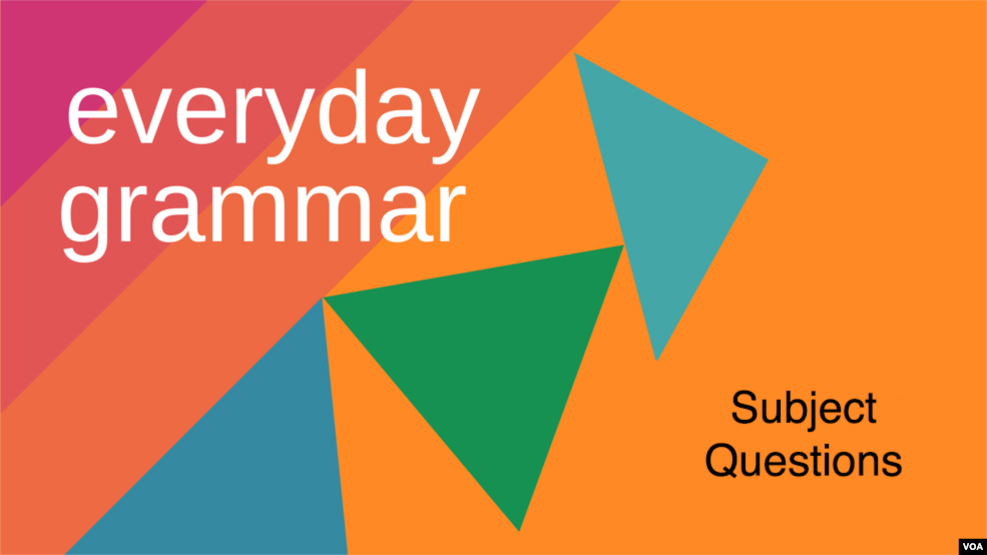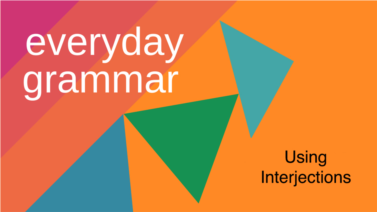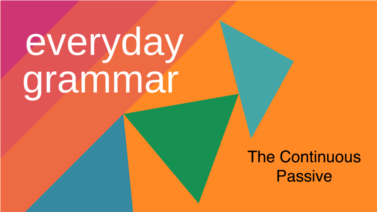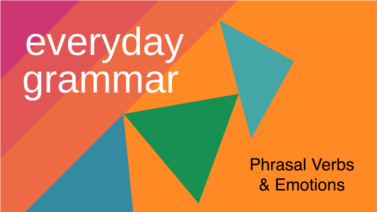
It would be impossible to go through life without asking questions. So, learning to form questions correctly is an important exercise for English learners. But it can also be one of the most frustrating ones.
There are a few reasons for this.
First, many questions use auxiliary verbs. Auxiliary verbs are known as “helping verbs.” We add them to main verbs to help make our meaning clearer. The verbs “do,” “be,” and “have” act as auxiliary verbs in many kinds of questions.
Second, there are about six kinds of questions in the English language. In earlier Everyday Grammar programs, we told you about three complex kinds: tag questions, reported questions and indirect questions.
But we have not yet told you about the three most basic kinds of questions: subject questions, object questions and yes or no questions. Each kind follows its own grammar rules.
Today, we’ll tell you about subject questions.
What are subject questions?
Subject questions are questions we ask when we want information about the subject of something. The subject of a sentence is the person or thing that performs the action.
We use subject questions to ask who or which person or thing does something: for example, “Who rode the train to work?” and “Which fruits make the best juice?”
Subject questions follow the same subject-verb structure as statements. “Who rode the train to work?” for example, has the same structure as its statement form would have: “I rode the train the work.” Unlike some kinds of questions, we do not invert the subject and verb in subject questions.
You can usually identify a subject question by looking for the word “who” or “which” at the beginning of it. But, not all questions beginning with these words are subject questions. We’ll say more on that later.
Simple tenses
You may have noticed that the examples “Who rode the train to work?” and “Which fruits make the best juice?” used simple verb tenses. Subject questions often use the simple tenses: simple present, simple past and simple future.
However, sometimes subject questions do use other verb tenses, usually the present continuous or past continuous. In those cases, you will see auxiliary verbs before the main verbs. Let’s hear examples of present and past continuous. Here is the present continuous:
Who is coming with me to pick up the supplies?
The auxiliary verb “be” appears as “is.” And here’s a past continuous:
Who was watching the dog when it got out?
The auxiliary verb “be” appears as “was.”
Using the auxiliary
Despite that subject questions with these verb tenses use the auxiliary verb “be,” subject questions with simple tenses do not use auxiliary verbs when the questions are positive.
Think back to one of the examples of a positive subject question. We did not say, “Who did ride the train to work?” We said, “Who rode the train to work?”
But suppose we wanted to ask a negative subject question. We would need to use the auxiliary verb “do.” And, the auxiliary appears immediately after the question word “who” or “which.” Listen to a subject question in its negative form:
Who didn’t ride the train to work?
The original question used the past tense verb “rode.” So, the negative version used “didn’t ride,” which is also the past tense.
Now let’s change another positive subject question into the negative. The question is “Who likes pizza?” Notice that it’s in the present tense. Let’s hear its negative version:
Who doesn’t like pizza?
Notice that the negative version “doesn’t like” is also in the present tense.
Avoiding confusion
Throughout your English learning, you may have seen positive questions that began with “who” or “which” but still use the auxiliary verb “do.” Listen to an example:
Who does she want to write about?
But do not be confused by this. This question is not asking about the subject. It is asking about the object. The answer, for example, might be “She wants to write about Malala Yousafzai.” Here, then, the question is really asking about the object, which is “Malala Yousafzai,” not about the subject, which is “she.” If it were a subject question, it would be something like this:
Who wants to write about Malala Yousafzai?
Again, notice the auxiliary verb “do” is not present.
Making subject questions
OK, now that you know the key features of a subject question, let’s hear a couple of statements and think about how to make them into subject questions.
Sherry broke the glass.
“Sherry” is the subject of the sentence. “Broke” is the verb and it’s in simple past. If we wanted to ask a question where the answer is the subject (“Sherry”), the question would be:
Who broke the glass?
Here’s another statement. Take a listen and think about how to make it into a subject question:
This motorbike gets the best gas mileage.
“This motorbike” is the subject. The verb is “gets” and is simple present. If we wanted to ask a question where the answer is the subject (“this motorbike”), we would ask:
Which motorbike gets the best gas mileage?
Forming questions in English can be tricky but understanding each kind can go a long way toward improving your English.
Join us again next week to learn more about forming questions.
I’m Alice Bryant.
Now, you try it! Make these sentences into subject questions:
I want to help you choose a wedding dress.
That movie is my favorite so far this year.
He painted a beautiful mural on 2nd Street.
We didn’t clean the bathroom or kitchen.
She is buying a new computer.
Alice Bryant wrote this story for Learning English. Caty Weaver was the editor.
Words in This Story
frustrating - adj. causing feelings of annoyance or anger
invert - v. to change the position, order, or relationship of things so that they are the opposite of what they had been
positive - adj. explicitly stated or expressed
negative - adj. expressing denial or refusal
feature - n. an interesting or important part, quality or ability
mileage - n. the average number of miles a vehicle will travel on a gallon of gasoline
mural - n. a usually large painting that is done directly on the surface of a wall


